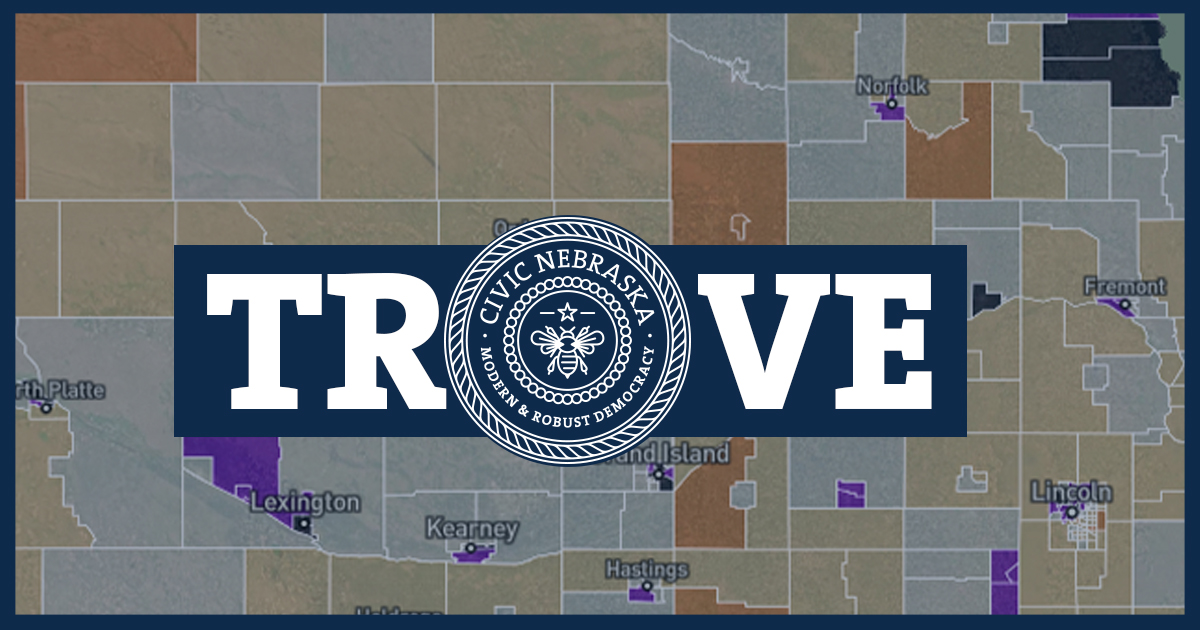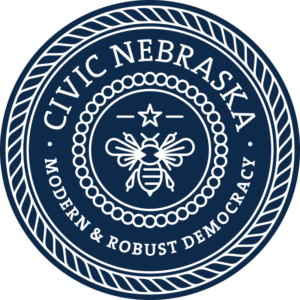Starting today [June 6], Nebraskans can delve into a TROVE of voter participation rates for their city, town, or neighborhood thanks to Civic Nebraska’s new mapping platform. This interactive Tool to Reflect Overall Voter Engagement shows voter turnout from the November 2022 general election down to the ZIP Code and census tract – eg, neighborhood – levels. In addition, TROVE compares voter participation against demographic characteristics of census tracts to analyze which may correlate to higher or lower voter turnout.
How to use TROVE
Users can choose any of three ways to view Nebraska’s 2022 voter turnout – at the Census Tract level, the ZIP Code level, or the County level. People in rural areas may find that the ZIP Code level provides the greatest level of detail. In urban areas, the Census tract level provides the greatest detail within a city’s neighborhoods. Users also can enter an address into the search bar to look up turnout exactly where they live.
In addition to voter turnout, TROVE tracks economic and social demographic data like median income, poverty, and race. Use the Census tract level to see that information.
Explanation of the data
The voter turnout data used in TROVE come from the Nebraska Secretary of State’s voter file. This file is a list of every registered voter in the State of Nebraska and includes data on whether or not an individual cast a ballot in previous elections. This file was pulled in early December 2022, and should very closely reflect the list of all registered voters at the time of the November 2022 election.
By geocoding voter addresses as latitude and longitude points, voter turnout is able to be calculated for a variety of geographic subdivisions. Demographic information was compiled from the U.S. Census Bureau’s 2021 American Community Survey Five-Year Estimates. Because of the small population in each census tract, estimates may have a larger margin of error.
Findings
Voter turnout varies widely across Nebraska and within our counties, cities, neighborhoods, and towns. The neighborhoods and towns with the highest turnout tend to have very low poverty, have higher percentages of high-school graduates, and have a higher percentage of the white population. The geographic concentration of low-turnout and high-turnout census tracts in specific areas of cities and communities means the collective voice of these areas to vote for leaders and issues that reflect their values and priorities is diluted at the city and state levels. Leaders and policymakers could discuss how race, poverty, a high school diploma, and geography relate to voter turnout in their communities and act to generate the means, connections, confidence, and motivation to ensure higher turnout in historically lower turnout areas. Read our initial report here.
Dig into the data
We invite you to use this new resource to explore different areas of the state and to draw conclusions based on your own analysis of the data we’ve provided here. If you’d like, please share your observations and/or conclusions based on your exploration – we’re interested to see how our fellow Nebraskans can use this tool to glean insights about our state’s electorate.
Join us on June 15 to learn more
Civic Nebraska will host a short webinar at noon CDT (11 am MDT) on June 15 to introduce TROVE, discuss best practices and potential applications, and answer any questions about the new tool. Register for this Zoom gathering here.



